Simons Collaboration on the Many Electron Problem Annual Meeting 2022
Organizer:
Andrew Millis
co-Director, Center for Computational Quantum Physics, The Flatiron Institute
and
Professor of Physics, Columbia University
Meeting goals:
The final meeting of the Many Electrons Collaboration will be devoted to a summary of progress on the Collaboration’s main focus areas of diagrammatic Monte Carlo, embedding methods, and electronic superconductivity, and to an assessment of the important open issues in the field.
Speakers:
Kristjian Haule, Rutgers University
Nikolay Prokof’ev, University of Massachusetts Amherst
Michel Ferrero, Ecole Polytechnique, Paris
Steven White, University of Califonia, Irvine
Emanuel Gull, University of Michigan
Lucas Wagner, University of Illinois
Dominika Zgid, University of Michigan
Tianyu Zhu, Yale University
-
The final annual meeting of the Many Electrons Collaboration was held at the Simons Foundation on February 10 and 11, 2022 (the collaboration formally ends in February 2023). The meeting had 56 in-person and 38 remote (Zoom) participants. In-person participation was limited by travel issues related to Covid-19, including exposure, travel restrictions, possibility of infection and being trapped by quarantine requirements.
The 2022 annual meeting was devoted to the current status of the collaboration’s main research themes. The collaboration was established in 2014. The end of the 2014–2019 funding period saw the launch of the Flatiron Institute’s Center for Computational Quantum Physics (CCQ) and a reconfiguration of the collaboration. The collaboration’s work provided much of the scientific case for CCQ. Several collaboration scientists along with some of the collaboration’s work moved to CCQ. For the 2019–2023 funding period, the collaboration was reconstituted at a smaller scale to support research that did not move to CCQ, including diagrammatic Monte Carlo (stochastic evaluation of Feynman diagrams) applied to both model systems and the homogeneous electron gas, multimethod approaches to model systems, in particular the Hubbard model, and novel embedding methods. A new PI, Lucas Wagner, was recruited for his work on downfolding methods.
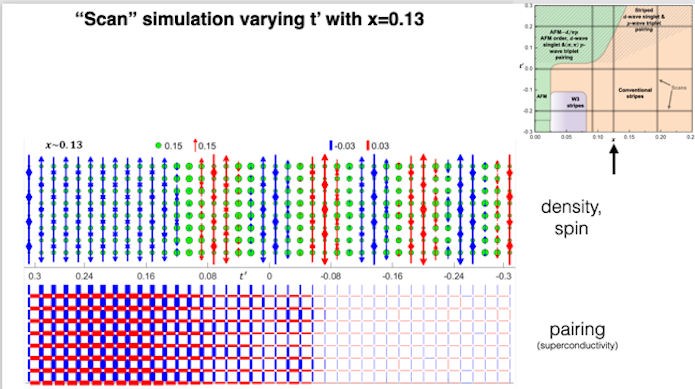 Steve White summarized the collaboration’s work on superconductivity in the two-dimensional Hubbard and t-J models in the stronger coupling regime where (to date) diagrammatic Monte Carlo methods do not work; the indications to date are, widespread expectations to the contrary, that this model most likely does not exhibit a superconducting phase diagram similar to the experimental phase diagram of the copper-oxide high transition temperature superconductors. The figure here shows scans of different band parameters demonstrating transition from superconducting to non-superconducting physics along with (upper right inset) the resulting phase diagram. Work over the next year is likely to nail down this issue and to bring a renewed focus on understanding what else is needed beyond the scope of the one band Hubbard model to explain cuprate superconductivity.
Steve White summarized the collaboration’s work on superconductivity in the two-dimensional Hubbard and t-J models in the stronger coupling regime where (to date) diagrammatic Monte Carlo methods do not work; the indications to date are, widespread expectations to the contrary, that this model most likely does not exhibit a superconducting phase diagram similar to the experimental phase diagram of the copper-oxide high transition temperature superconductors. The figure here shows scans of different band parameters demonstrating transition from superconducting to non-superconducting physics along with (upper right inset) the resulting phase diagram. Work over the next year is likely to nail down this issue and to bring a renewed focus on understanding what else is needed beyond the scope of the one band Hubbard model to explain cuprate superconductivity.The 2022 annual meeting featured three talks on diagrammatic Monte Carlo. Kristjan Haule gave an impressive overview of the successes of diagrammatic Monte Carlo methods for the uniform electron gas. Results that he has obtained with collaboration members Nikolay Prokof’ev and Boris Svistunov show that methods reproduce known benchmark results, provide new results for electron densities relevant to metals, and shed substantial light on the accuracy of the widely used GW approximation (which was shown to overestimate bandwidths) and of local approximations to the interaction physics (which were seen to be remarkably good, even for simple metals). It was also showed that application of diagrammatic Monte Carlo to the calculation of real frequency quantities provides nontrivial insights into the heretofore unknown and very crudely approximated functionals needed in the widely used time dependent density functional approximation.
Nikolay Prokof’ev (substituting for Boris Svistunov, whose attendance was prevented by Covid-19) presented advances in the diagrammatic Monte Carlo approach to superconductivity. From a technical point of view, he showed how an efficiently downfolded theory incorporating the frequency dependence of the interaction could be implemented; important physics results included finally settling a five-decade-old question of superconductivity in the electron gas with repulsive Coulomb interaction by showing that the “Kohn-Luttinger” (momentum dependence arising from Fermi-edge singularities) mechanism for superconductivity is not dominant, at least in the uniform electron gas, because the frequency dependence of the emergent effective interaction is much more important. Prokof’ev also provided new insights into superconductivity in dilute systems of electrons coupled to lattice vibrations (phonons), showing that previously neglected types of polarons provide a potential route to high transition temperatures.
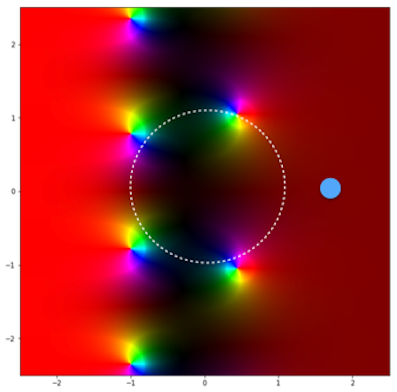 Michel Ferrero reported recent progress in understanding the analytic structure the series stochastically generated by diagrammatic Monte Carlo in terms of controlling the locations of poles in the plane of complex interaction parameter (see figure). He discussed how it inspired new algorithmic developments and presented greatly improved results for the two-dimensional Hubbard model, a basic theoretical model in the field. Combining these results with those from other methods, he reported a “multimessenger” study of the two-dimensional Hubbard model which has to a large extent characterized the weak-intermediate coupling physics of the model, characterizing the phase diagram and resolving multiple longstanding questions in the field. These results demonstrate that the methods have “come of age” with the power and potential for problems of direct and broad interest in materials science.
Michel Ferrero reported recent progress in understanding the analytic structure the series stochastically generated by diagrammatic Monte Carlo in terms of controlling the locations of poles in the plane of complex interaction parameter (see figure). He discussed how it inspired new algorithmic developments and presented greatly improved results for the two-dimensional Hubbard model, a basic theoretical model in the field. Combining these results with those from other methods, he reported a “multimessenger” study of the two-dimensional Hubbard model which has to a large extent characterized the weak-intermediate coupling physics of the model, characterizing the phase diagram and resolving multiple longstanding questions in the field. These results demonstrate that the methods have “come of age” with the power and potential for problems of direct and broad interest in materials science.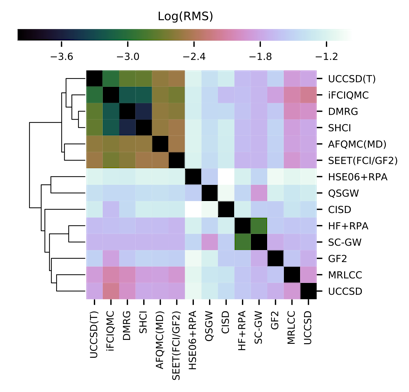 Lucas Wagner, Dominika Zgid and Tianyu Zhu (former collaboration postdoc, now assistant professor of chemistry at Yale, substituting for collaboration PI Garnet Chan, who was unable to attend for family reasons) presented different perspectives on embedding theories, in which the full complexity of the many body quantum problem is addressed by embedding a smaller fragment (which is solved in full quantum detail) self consistently embedded into an infinite system whose properties are solved by a low-order approximate method. Wagner discussed downfolding and benchmarking in the context of small molecules showing the relative accuracy of different methods (see figure) and presented new approaches to defining the Hamiltonian for the embedded fragment. Zgid focused on issues related to the low-order approximate solver, presenting new implementations and results for all electron GW treatments, relativistic corrections and results from the ‘SEET’ method of embedding.
Lucas Wagner, Dominika Zgid and Tianyu Zhu (former collaboration postdoc, now assistant professor of chemistry at Yale, substituting for collaboration PI Garnet Chan, who was unable to attend for family reasons) presented different perspectives on embedding theories, in which the full complexity of the many body quantum problem is addressed by embedding a smaller fragment (which is solved in full quantum detail) self consistently embedded into an infinite system whose properties are solved by a low-order approximate method. Wagner discussed downfolding and benchmarking in the context of small molecules showing the relative accuracy of different methods (see figure) and presented new approaches to defining the Hamiltonian for the embedded fragment. Zgid focused on issues related to the low-order approximate solver, presenting new implementations and results for all electron GW treatments, relativistic corrections and results from the ‘SEET’ method of embedding. 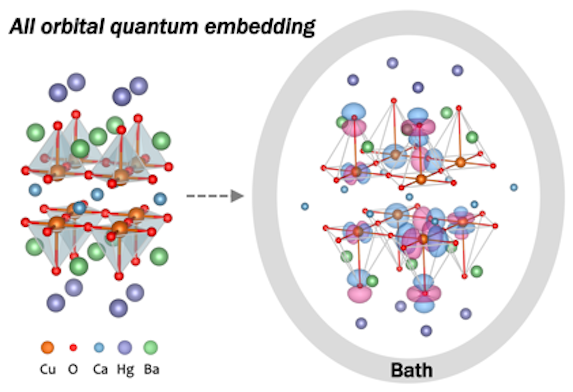 Zhu presented an all-orbital embedding approach that avoids the problem of downfolding interactions by greatly increasing the complexity of the embedded cluster (see figure), requiring new cluster solvers. Along with the theory, promising results for magnetic spectra of high Tc copper oxide superconductors were presented along with remarkable results for the Kondo effect of magnetic impurities in realistic environments.
Zhu presented an all-orbital embedding approach that avoids the problem of downfolding interactions by greatly increasing the complexity of the embedded cluster (see figure), requiring new cluster solvers. Along with the theory, promising results for magnetic spectra of high Tc copper oxide superconductors were presented along with remarkable results for the Kondo effect of magnetic impurities in realistic environments.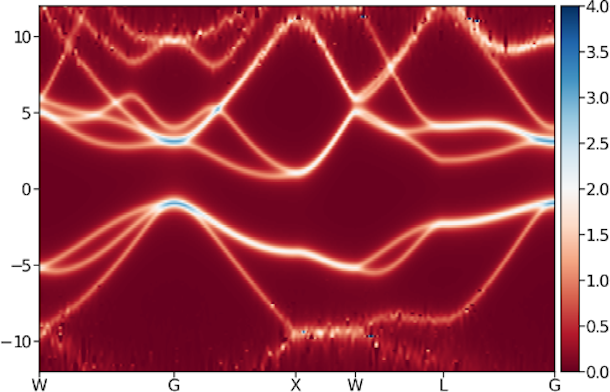
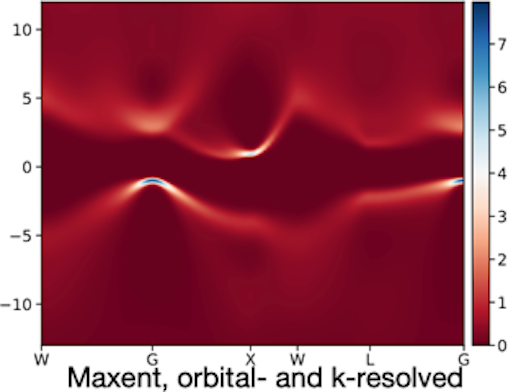 Solving the many electrons problem requires solving a wide variety of numerical problems, for many of which the available algorithms are very primitive. Emanuel Gull drew on 100-year-old mathematical results of complex analysis to overcome one of the main limitations of finite-temperature many-body calculations, analytically continuing numerical data from the imaginary frequencies where computations can easily be performed to the real frequencies needed to interpret experiments. We show here on the left the momentum and frequency resolved spectrum of Si (in the GW method) obtained by the previous state of the art method (“Maximum entropy,” top panel) and the new Nevanlinna method (bottom panel). Figures from Phys. Rev. B104, 165101.
Solving the many electrons problem requires solving a wide variety of numerical problems, for many of which the available algorithms are very primitive. Emanuel Gull drew on 100-year-old mathematical results of complex analysis to overcome one of the main limitations of finite-temperature many-body calculations, analytically continuing numerical data from the imaginary frequencies where computations can easily be performed to the real frequencies needed to interpret experiments. We show here on the left the momentum and frequency resolved spectrum of Si (in the GW method) obtained by the previous state of the art method (“Maximum entropy,” top panel) and the new Nevanlinna method (bottom panel). Figures from Phys. Rev. B104, 165101. -
Thursday, February 10
9:30 AM Kristjian Haule | From the electron gas to the lattice dynamics of correlated electron materials 11:00 AM Nikolay Prokof’ev (substituting for Boris Svistunov) | New insights into the problem of Cooper instability: Uniform electron gas and bond bipolarons 1:00 PM Michel Ferrero | The weak, the strong and the long: correlation regimes of the Hubbard model 2:30 PM Steven White | Superconductivity in the Hubbard model 4:00 PM Emanuel Gull | Analytical continuation revisited: connections to Nevanlinna theory and applications Friday, February 11
8:30 AM CHECK-IN & BREAKFAST 9:30 AM Lucas Wagner | Systematic verification of embedding and downfolding methods: high accuracy reference data on first principles systems using quantum Monte Carlo 11:00 AM Dominika Zgid | Ab-initio Green's function embedding methods 1:00 PM Tianyu Zhu | All orbital embedding theories